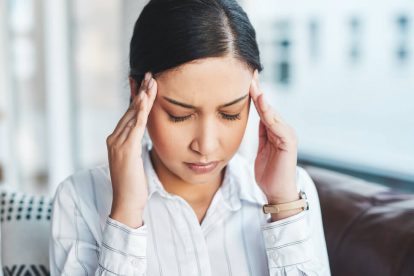Using Exercise as GAD Treatment Opens Up Options for Recovery

Generalized anxiety disorder (GAD) can be a frustrating and debilitating condition that interferes with your emotions, thoughts, and behaviors. Today, however, there are more treatment options than ever before, opening up new paths to recovery. A growing body of evidence now shows that exercise can be one of those treatment options, allowing you to alleviate distressing symptoms and creating a sense of calm and wellbeing. By choosing the best exercise for you and incorporating it into your GAD treatment, you can reap a myriad of psychological benefits and gain control of your anxiety.
“I was walking around in a constant state of fear,” Emma says. “It wasn’t an acute fear all the time, but something that seemed to be lurking underneath constantly. At first, it seemed like I was worried about rational things I should be worried about—a job interview, my kids getting sick, getting in a car accident—but slowly it became clear that my anxiety wasn’t rational. It was something more.”
Emma was diagnosed with generalized anxiety disorder (GAD) when she was 32 years old. Her first psychiatrist put her on Lexapro and gave her benzodiazepines for when things got really bad. “It helped,” she remembers. “But it wasn’t enough. My anxiety had gotten to the point where it was seriously interfering with not just my emotional wellbeing, but my functionality. It was limiting what I could do.” Despite adding weekly therapy to her treatment plan and modifying her medication, Emma’s anxiety remained persistent. “It took a while to admit that I needed residential treatment, but that’s what finally helped me take back control of my life.”
In residential treatment, Emma finally found the kind of GAD treatment she needed to break through her overwhelming anxiety. She was able to participate in a broad range of therapies that allowed her to both explore the roots of her anxiety and develop meaningful skills to cope with her feelings. However, one of the most important components of her treatment came in an unexpected form. “Exercise was vital to my recovery,” she says. “It wasn’t as simple as going for a run and then everything would be okay, but exercise added another dimension to my treatment. It has become a critical part of my ongoing self-care and allows me to feel a sense of control over my disorder.”
When you are struggling with generalized anxiety disorder, it can seem as if exercise is unlikely to break through your worried state. This may be particularly true if you have not found relief via more seemingly intensive methods of treatment, such as medication. However, research consistently shows that exercise can be an important part of GAD treatment and a growing number of people with the disorder are discovering the difference it can make in their recovery process.
What the Evidence Tells Us About Exercise for GAD
The possibility of using exercise to treat mental health disorders is a growing area of interest amongst researchers, clinicians, and patients alike. As a result, we are now seeing the emergence of a robust body of literature suggesting that exercise can have a positive impact on a number of anxiety disorders, including GAD. According to a 2013 review, for example, “Preliminary data suggest that exercise training can serve as an alternative therapy for patients with […] generalized anxiety disorder.” Significantly, the review found that “anxiety reductions appear to be comparable to empirically supported treatments [for GAD],” which means that it may be used both in addition to and in place of treatments such as medication and cognitive behavioral therapy (CBT), potentially allowing you to decrease dependence on other forms of intervention.
In addition to confirming that exercise can be used as GAD treatment, studies have also elucidated the neural mechanisms behind this phenomenon. Specifically, exercise is believed to impact important neurotransmitter activity as well as stimulating critical areas of the brain in a way that reduces anxious responses. As one research cohort led by Dr. Lindsey DeBoer points out, “Animal studies have demonstrated that exercise produces similar alterations in neural systems alterations in neural systems, such as the serotonergic and noradrenergic systems, which are presumed to underlie pharmacologic treatments for depression and anxiety.” These alterations include increased serotonin levels, lower cortisol levels, and increased GABA concentrations, all of which can increase feelings of wellbeing and potentially counteract the neurotransmitter dysfunction associated with GAD.
However, exercise has also been found to produce new, excitable brain cells, which, until recently, seemed at odds with the calming effects exercise can have as these excitable brain cells are particularly vulnerable to anxious responses. In 2013, researchers at Princeton University sought to better understand this apparent contradiction and, in the process, came to produce new knowledge about how exercise functions to counteract anxiety. Using mouse models, they found that while mice that exercised did indeed have new, excitable brain cells in higher numbers than sedentary mice, a “notable number” of those new brain cells were “specifically designed to release the neurotransmitter GABA, which inhibits brain activity, keeping other neurons from firing easily.” In other words, many of the newly developed neurons are of a type that reduces overall anxiety levels.
The impact of this was further explored by testing the response of the mice in a cold bath. The researchers found that excitable cells fired in both the exercising and sedentary mice when exposed to the stress of the cold bath, but this response was short-lived in the exercising mice. As Gretchen Reynolds writes in The New York Times:
The brains, unlike those of the sedentary animals, showed evidence that the shushing neurons also had been activated in large numbers, releasing GABA, calming the excitable neurons’ activity, and presumably keeping unnecessary anxiety at bay. In effect, the runners’ brains had responded to the relatively minor stress of a cold bath with a quick rush of worry and a concomitant, overarching calm.
Significantly, this response was not tested immediately following exercise. Rather, the mice had not exercised at all in the 24 hours leading up to the cold baths, suggesting that the impact of exercise on the brain is durable rather than ephemeral, representing a “fundamental remodeling of [the brain].”
In addition to improving anxiety directly, exercise has been found to reduce physical tension, improve sleep, reduce fatigue, improve concentration, and stabilize mood. Additionally, many people find that exercise increases their self-esteem both due to the neurochemical effects of exercise itself as well as feelings of pride in their physical accomplishments.
What is the Best Exercise for GAD?
Most of the research confirming the benefits of exercise in GAD treatment has concentrated on aerobic exercises, such as running. Unfortunately, many people struggling with GAD may feel overwhelmed by the prospect of starting a workout regime, particularly if they are used to a sedentary lifestyle. But exercise doesn’t have to be intense or prolonged in order to confer meaningful benefits. According to the Anxiety and Depression Association of America, “Psychologists studying how exercise relieves anxiety and depression suggest that a 10-minute walk may be just as good as a 45-minute workout.”
Where you exercise, however, can make a difference. Researchers have found that people hiking in natural environments report reduced stress levels and less rumination than people who walk in urban settings. These self-reports were strengthened by brain imaging studies showing that people who walked in nature had “less blood flow to the subgenual prefrontal cortex,” an area of the brain associated with rumination. This suggests that seeking out natural environments may be particularly important for people who live in or near cities. “I’d say there’s mounting evidence that, for urbanites and suburbanites, nature experience increases positive mood and decreases negative mood,” says Greg Bratman, a research fellow at Stanford University and co-author of the study.
The best exercise, of course, is the exercise you do. Setting unrealistic goals for yourself or picking an activity that you don’t enjoy means you are unlikely to stick with a regular exercise program. Explore your interests and see where they take you. For some, exercising in a group can make working out more fun, help you stay motivated, and experience the benefits of socialization and camaraderie while keeping active. Whether you’re walking, running, cycling, horseback riding, or taking hot yoga classes, the important thing is that you stick to it.
Anxiety is the Most Common Mental Disorder
Recovery is Easier than You Might Think
Incorporating Exercise in GAD Treatment
While it is undeniable that exercise can be a significant part of the GAD treatment process, it is important to remember that exercise alone is often not enough to create lasting relief from symptoms. Often, connecting with a comprehensive treatment program is essential for healing from GAD, allowing you to explore the causes of your condition and find effective strategies for coping via individual psychotherapy and a range of group therapies. Medication may also be appropriate to help you address your symptoms and create the mental space to more fully participate in other forms of treatment. However, a growing number of high-quality programs now emphasize a multidimensional approach to GAD treatment and offer physical fitness programming as an integral part of the treatment process, harnessing the potential of activities like exercise to help you achieve better mental health. By seeking out a program that offers opportunities for exercise, you can ensure you are opening up every possibility for recovery, both during and after your time in treatment.
“Exercise is something I can turn to every day,” says Emma. “It’s always available to me and it gives me a sense of self-determination in my recovery journey. It’s something I can do for myself in order to keep myself healthy and balanced and that is very empowering.”
Bridges to Recovery offers comprehensive treatment for people struggling with mental health disorders as well as process addictions. Contact us to learn more about our renowned Los Angeles programs and how we can help you or your loved one start on the path to healing.






